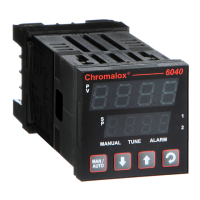96
before calculating a set of PID values. Successive de-
viation oscillation causes values to be recalculated so
that the controller rapidly converges on optimal control.
When the controller is switched off, the final PID terms
remain stored in the controller’s non-volatile memory,
and are used as starting values at the next switch on.
The stored values may not always be valid, if for in-
stance the controller is brand new or the application
has been changed. In these cases the user can utilize
Pre-Tune to establish new initial values.
Use of continuous self-tuning is not always appropri-
ate for applications which are frequently subjected to
artificial load disturbances, for example where an oven
door is likely to be frequently left open for extended
periods of time.
The Self-Tune feature on Valve Motor Drive controllers
always sets the Rate parameter to zero (OFF) because
derivative action is not usually desirable in these ap-
plications.
Self-Tune cannot be engaged if a controller is set for
On-Off Control.
Also refer to Minimum Motor On Time, On-Off Control,
Pre-Tune, PID, and Tuning.
Serial Communications Option
Type: General Denition
An feature that allows other devices such as PC’s,
PLC’s or a master controller to read or change an in-
struments parameters via an RS485 Serial link. Full de-
tails can be found in the Serial Communications sec-
tions of this manual.
Also refer to Controller, Indicator, Master & Slave, Limit
Controller and PLC
Set Valve Closed Position
Type: VMD Controller Parameter
When Valve Position Indication is to be used on Valve
Motor Controllers, this parameter defines the input val-
ue that will be measured by the Auxiliary Input, when
the valve is fully closed. The valve must drive to its
“Closed” end stop before setting this parameter.
It must not be used to limit valve movement, separate
Valve Close and Open Limit parameters are available
for this purpose.
Display code = PcUL, default setting = Auxiliary Input
Range Minimum.
Also refer to Auxiliary Input, Set Valve Opened Position,
Valve Close Limit, Valve Open Limit, Valve Motor Con-
trol and Valve Position Indication.
Set Valve Opened Position
Type: VMD Controller Parameter
When Valve Position Indication is to be used on Valve
Motor Controllers, this parameter defines the input val-
ue that will be measured by the Auxiliary Input, when
the valve is fully opened. The valve must drive to its
“Open” end stop before setting this parameter.
It must not be used to limit valve movement, separate
Valve Close and Open Limit parameters are available
for this purpose.
Display code = PcLL, default setting = Auxiliary Input
Range Maximum.
Also refer to Auxiliary Input, Set Valve Closed Position,
Valve Close Limit, Valve Open Limit, Valve Motor Con-
trol and Valve Position Indication.
Setpoint
Type: Controller Denition
The target value at which a controller will attempt to
maintain the process variable by adjusting its power
output level. Controllers can have either one or two set-
points. These can be one or two local internal setpoints
(SP or SP1 and SP2), or one local internal setpoint
(LSP) and one externally adjusted remote (rSP) set-
point, if a Remote Setpoint module is fitted. The value
of the setpoints can be adjusted between the Setpoint
Upper Limit and Setpoint Lower Limits. The active set-
point is defined by the status of the Setpoint Select
parameter or a digital input.
Also refer to Limit Setpoint, Process Variable, Remote
Setpoint, Scale Range Lower Limit, Setpoint Lower
Limit, Setpoint Upper Limit and Setpoint Select
Setpoint Upper Limit
Type: Controller Parameter
The maximum limit allowed for operator setpoint ad-
justments. It should be set to keep the setpoint below
a value that might cause damage to the process. The
adjustment range is between Scale Range Upper Limit
and Scale Range Lower Limit. The value cannot be
moved below the current value of the setpoint.
Display code = SPuL, default value is Scale Range Up-
per Limit.
Also refer to Scale Range Lower Limit, Scale Range
Upper Limit, Setpoint and Setpoint Lower Limit.
Setpoint Lower Limit
Type: Controller Parameter
The minimum limit allowed for operator setpoint ad-
justments. It should be set to keep the setpoint above
a value that might cause damage to the process. The
adjustment range is between Scale Range Lowe Limit
and Scale Range Upper Limit. The value cannot be
moved above the current value of the setpoint.
Display code = SPLL, default value = Scale Range
Lower Limit.
Also refer to Scale Range Lower Limit, Scale Range
Upper Limit, Setpoint and Setpoint Upper Limit.

